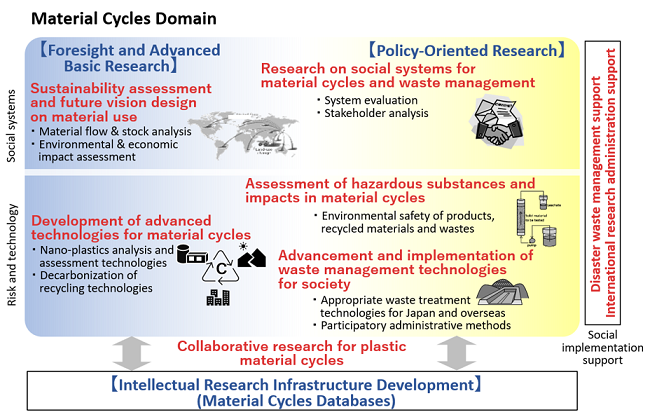- Director
- Outline of Research
- Research Staff
- Database / Tool
Director

Director of Material Cycles Division
NANSAI Keisuke
Outline of Research
Contributing solutions for sustainable usage of resources and the reduction of the environmental burden which accompanies that use
Under the Fifth Mid-and-Long Term Research Plan (FY2021-FY2025), the Material Cycles Division conducts the following research activities.
- Assessment of material flows and stocks and their environmental impacts throughout life cycle from resource to waste in terms of current status and future situation; and proposing appropriate management methods for the material cycles that contribute to reduction of environmental burden and improvement of resource efficiency
- Development of technologies and systems for circular material use, proper waste treatment and disposal, and environmental remediation; and adaptation of these technologies and systems to the conditions of developing countries
For more details, please see the Division’s website.

Research Staff
Database / Tool
-
 Database on municipal solid waste management in the Asia-Pacific Region (DaMSAR)Database related to the SDG Indicator 11.6.1 on municipal solid waste management in developing countries of the Asia-Pacific region.
Database on municipal solid waste management in the Asia-Pacific Region (DaMSAR)Database related to the SDG Indicator 11.6.1 on municipal solid waste management in developing countries of the Asia-Pacific region.
-
 Database on Sustainabiligy Indicators (SDI) adopted by national governments, etc.Scope of the database covers 28 countries, regions, and international organizations listed and 1,848 types of indicators.
Database on Sustainabiligy Indicators (SDI) adopted by national governments, etc.Scope of the database covers 28 countries, regions, and international organizations listed and 1,848 types of indicators.
-
 Embodied Energy and Emission Intensity Data for Japan Using Input-Output Tables (3EID)Database compiling embodied environmental burden intensities for approximately 400 sectors of economic activity in 1990 and 1995.
Embodied Energy and Emission Intensity Data for Japan Using Input-Output Tables (3EID)Database compiling embodied environmental burden intensities for approximately 400 sectors of economic activity in 1990 and 1995.
-
 Lifespan database for Vehicles, Equipment, and Structures: LiVESThe Lifespan database for Vehicles, Equipment and Structures (LiVES) is a database based on lifespan and usage data for commodities, containing information collated from a variety of sources, such as national statistical surveys; research papers; and reports by industrial bodies.
Lifespan database for Vehicles, Equipment, and Structures: LiVESThe Lifespan database for Vehicles, Equipment and Structures (LiVES) is a database based on lifespan and usage data for commodities, containing information collated from a variety of sources, such as national statistical surveys; research papers; and reports by industrial bodies.
-
 Decarbonized Lifestyle Options for 52 Japanese citiesThis database provides the carbon footprints by the average citizen of 52 major Japanese cities; 65 decarbonized lifestyle options related to mobility, housing, food, leisure, and consumer goods; and city-wise greenhouse gas reduction potentials.
Decarbonized Lifestyle Options for 52 Japanese citiesThis database provides the carbon footprints by the average citizen of 52 major Japanese cities; 65 decarbonized lifestyle options related to mobility, housing, food, leisure, and consumer goods; and city-wise greenhouse gas reduction potentials.
- Institute Overview
- Organization
- Executives
- Administration Department
- Earth System Division
- Material Cycles Division
- Health and Environmental Risk Division
- Regional Environment Conservation Division
- Biodiversity Division
- Social Systems Division
- Center for Climate Change Adaptation
- Fukushima Regional Collaborative Research Center (FRECC)
- Lake Biwa Branch Office
- Wako Branch Office
- Research Staff
- Jobs at NIES
- Privacy Policy of NIES
- Faclities
- Access and Benefit-Sharing of Genetic Resources